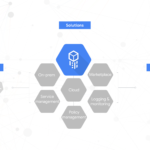Samsung’s Galaxy S10 lineup arrives with four new models
In what may well be the most Samsung move in Samsung history, Samsung just introduced four new Samsung S10 models. For the 10th anniversary of the flagship line, Samsung is going all in on this thing. And with more information expected on Samsung’s upcoming foldable, well, that’s a lot of Samsungs, Samsung.
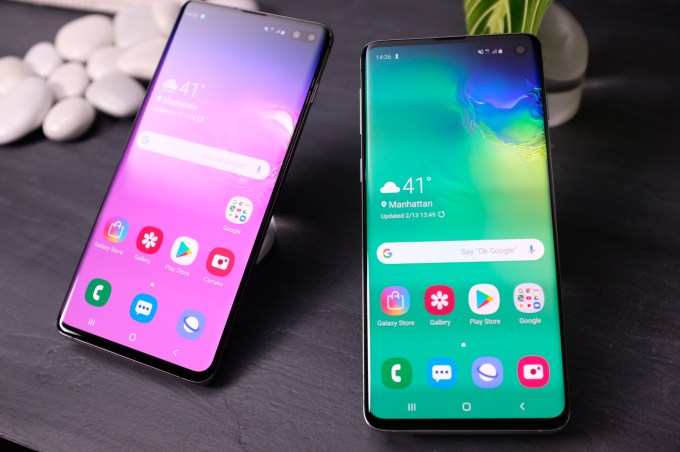
Before we dive in to what’s bound to be a lot of words about a lot of phones, here’s the basic breakdown of the line:
S10: The flagship. 6.1 inch. Starts at $900.
S10+: A little bigger, a little better. 6.4 inch. Starts at $1,000.
S10e: The [E]ntry level or [E]conomy or [E]gads that’s a lot of new phones. The Galaxy’s take on the iPhone XR. 5.8 inch. Starts at $750.
S10 5G: All the bells, all the whistles and whistles with bells on them. 6.7 inch. Starts at $?!?!?!?!?
And hey, look, Greg made a handy chart of all of the key specs.
As for what’s new beyond the sheer number of devices, the top-line features are as follows: edge-to-edge display with pinhole cutout, three rear-facing cameras and Wireless PowerShare, which uses the phone to wirelessly charge other handsets and the company’s new Galaxy Buds. Of course, some of those features vary by SKU.
Unlike the 10th anniversary iPhone a couple of years back, the S10 isn’t an attempt to rethink the product on the occasion of the line’s own first decade. Instead, the device finds Samsung adding more flagship features atop of what is already a pretty massive pile.
Those who’ve followed the Galaxy line with even passing interest will find that the S10 looks pretty familiar. The most distinguishing bit of design language this time out is, naturally, the “Infinity-O” display. One of several screen technologies the company highlighted at last year’s developer conference, the “O” is exactly what it sounds like — a hole punch up top for the camera to peek through.
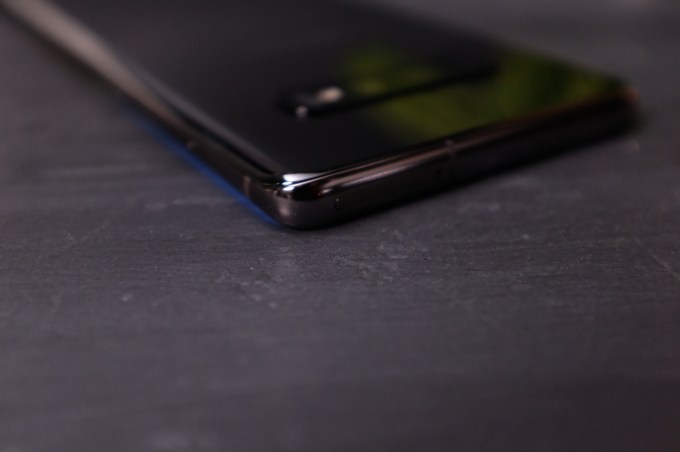
Unlike most of the rest of the industry, Samsung just skipped over that whole notch business, in favor of even more screen. Of course, the S10’s not the first handset with a pinhole — hell, it’s not even the first Samsung with one. That designation, interestingly enough, belongs to the A8, a mid-range handset introduced late last year for the China market — surely an indication of a company dealing with increased pressure from companies like Huawei and Xiaomi.
The company says the feature was designed with a “precision laser,” leaving the phone with an impressive screen-to-body ratio of 93.1 percent. This is helped along with the addition of an under-display fingerprint reader. Again, the S10 isn’t the first handset with an in-screen fingerprint sensor (OnePlus, among others, brought one to market last year), but the company is among the first to use Qualcomm’s new technology.
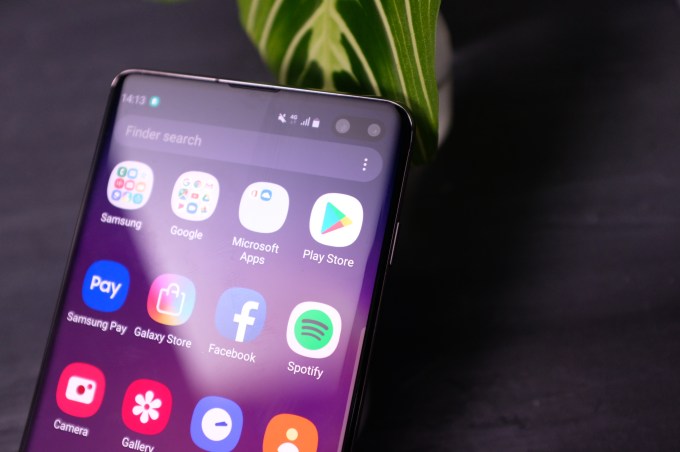
Announced in December at the Snapdragon summit, the reader adds an extra level of security beyond some of the already available options. The ultrasonic technology gives the system a fuller, more three-dimensional look at the fingerprint, making it more difficult for would-be thieves to spoof. Fingerprint info is stored on-device in a secure Knox folder.
It can be activated without turning the screen on, for quicker access, though, notably, may have some difficulty with thicker screen protectors. Samsung — and, likely, everyone else who utilizes Qualcomm’s new tech — will be working with accessory makers to market ones that play nicely with the tech.
The most fun feature here is, no doubt, Wireless PowerShare. It’s another spot where Huawei beat the company to the punch, but it’s a compelling feature nonetheless — and hey, it definitely beat Apple to the feature. Closest you get for iOS devices is the new iPad Pro’s ability to charge handsets via USB-C.
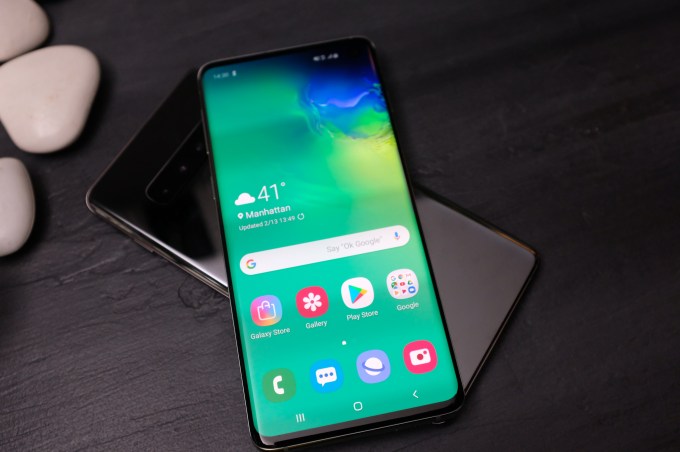
Here, all of the charging is done on contact — which means, granted, that you won’t be getting much use out of the phone while using the feature. It’s still handy, particularly when traveling. Plug in the S10. Plop it down and charge up another handset while you charge it up. The tech is compatible with Qi, so it will play nicely with third-party charging pads. It also, naturally, works with the Galaxy Buds, Samsung’s newly announced Bluetooth earbuds that beat Apple to the punch with a wireless charging case.
All of this is powered by some pretty beefy batteries, at 3,100 mAh for the S10e, 3,400 for the S10 and 4,100 for the S10+. Samsung notably began loosening up a bit on battery size last year, with its Note 7 woes now safely in the rear-view. As a matter of fact, the 5G packs a whopping 4,500 mAh battery to help offset drain from cellular usage and that massive display.
Of course, it wouldn’t be a new Galaxy without some camera news. Once again, the leaks were true. The base-line sports three cameras, configured horizontally, along with a flash. Honestly, the cutout looks a bit like a Microsoft Kinect camera configuration. What, precisely, the three lenses do wasn’t clear until now, however. After all, handset makers are using multiple camera setups for all manner of different reasons.

Here, the different cameras are being put to use to offer different focal points. There’s an ultra-wide lens offering 123-degree shots (16 megapixel), a standard wide lens with 77-degree shots and a third that does 2x optical zoom (both 12 megapixel). Rear-facing video gets improved digital image stabilization, while the front-facing can now do 4K, for ultra-high-res selfies, I suppose.
Of course, most of the camera upgrades we’ll be seeing in the foreseeable future will be powered by software, and as such, there are a number of improvements on that side, as well. Most notably is the use of neural processing to identify up to 30 different scenes and offer shot suggestions accordingly. Again, similar to much of the AI applications currently in use with various different Android handsets — as ever, I’m excited to get my hands on the damn thing to take it through its paces.
All of the above are, naturally, 1P68 — and yes, the headphone jack is still on-board. Samsung has done a good job turning that one-time ubiquitous port into a feature and differentiator from an increasing number of competitors. All sport the latest Snapdragon 855, and the S10 offers up to 1TB of storage.
Pre-orders for the S10e, S10 and S10+ start February 21. The handsets go on sale March 8. The 5G, meanwhile, is set to arrive at some point in Q2, as a Verizon exclusive. Sprint and T-Mobile versions will follow later.
Powered by WPeMatico
Samsung’s ‘budget flagship’ the Galaxy S10e starts at $750
Samsung just announced a lot of phones — four major variants of the Galaxy S10, as a matter of fact. The S10e is the most interesting of the bunch — or at least the most interesting one that doesn’t sport 5G.
The handset is the budget variant of the flagship. In other words, it’s sort of like Samsung’s take on the iPhone XR. At $750, it’s not cheap, cheap. The company’s got plenty of phones that fit that bill, if you’re on a budget. Instead, it’s a reasonably affordable alternative to the ever-escalating price of flagships — and a way to get a version of the S10 without breaking the bank.
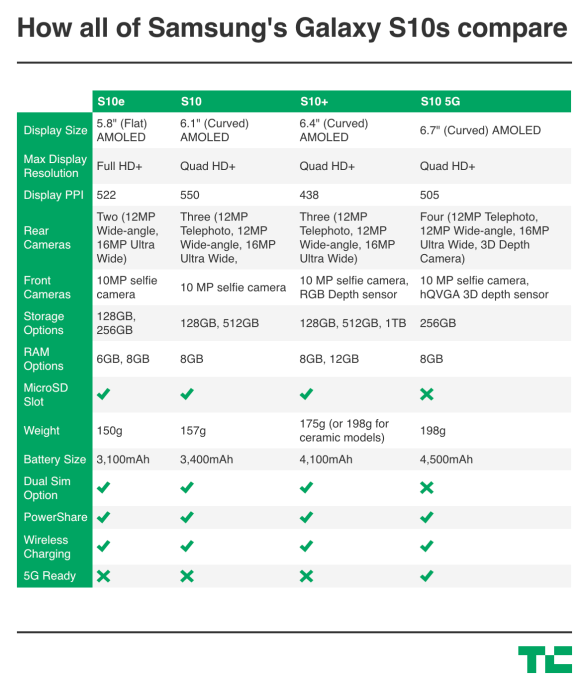
Like the iPhone XR, the S10e is a tacit acknowledgement that flagship phones have been priced out of the reach of many users. It’s also an attempt to appeal to developing markets, while reacting to slowed upgrade cycles and increased pricing competitions from companies like Huawei, who have demonstrated that flagships don’t need to cost an arm and a leg.
The handset sports a 5.8-inch display and a 3,100mAh battery. It’s up for pre-order February 21 and goes on sale March 8.
Powered by WPeMatico
The Samsung S10 gets a 5G model
You saw this one coming, right? Last year Samsung announced it would be launching not one — but two — 5G phones. It only follows then that the first one would be a 5G variant of its flagship (a Note 5G, one imagines, is on the way for the second half of the year).
Never mind the fact that 5G is still a ways away in just about every market — Samsung’s taking an educated gamble that some percentage of its early adopting/cost is no object approach will get in early on the next generation of cellular technology. Samsung, for its part, has always been keen to jam as many features into a handset as possible, and the S10 5G is, without question, the most Samsung phone to date.
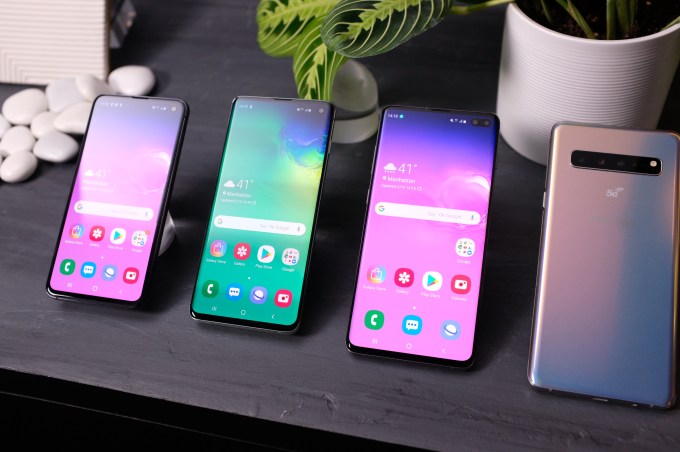
With the sole exception of storage (which goes up to an utterly insane 1TB on the S10+), the 5G is the smartphone for that discerning Galaxy fan who wants the biggest and best of everything, regardless of price. In fact, the company didn’t bother mentioning price at today’s event, which is not a particularly great sign for those hoping to pick up the handset without taking out a mortgage on their home.
Considering the fact that the S10+ starts at $1,000, it doesn’t take an industry analyst to extrapolate that this thing is going to be pricey. Samsung likely doesn’t expect to move a ton of these things, but when it comes to the company’s place in the industry, the optics of demonstrating that it can be first — or at least one of the first — to market with a next-gen tech is also important.
The 5G sports a whopping 6.7-inch display, putting it well above the S10+’s already massive 6.3-inch display. This is a device designed for showing off. As such, it sports a massive “5G” logo on the rear, just so there’s no mistaking it for a lowly S10+. Of course, that massive screen and the on-again-off-again 5G is going to be a heck of a power drain (though Samsung says it hasn’t run — or at least published — those tests).

So, naturally, the device also has a massive battery — 4,500mAh, to be exact. At the very least, that should be enough to ensure that the phone gets a full day of life.
The Samsung S10 5G will be arriving as a Verizon exclusive in Q2 and will hit AT&T later that quarter. Sprint and T-Mobile models will arrive later this year.
Powered by WPeMatico
Citymapper announces subscription service for multiple transportation methods
Citymapper is becoming a fintech startup, sort of. The company announced a prepaid card called Citymapper Pass for users based in London. This new product is both a subscription service to aggregate all your transportation subscriptions and a plastic card to pay for your rides.
According to Wired, Citymapper will start with two weekly subscription packages. For £30 per week, you’ll get full access to zone 1 and 2 on TfL’s network. For an additional £10 per week, you’ll also get unlimited Santander bike rides and two rides using Citymapper’s ride-sharing service.
This isn’t exactly revolutionary for London commuters, but it’s a start. Eventually, the startup wants to add more transport methods, from dockless bikes to e-scooters and other private networks. But this is going to be a bit more complicated as the startup needs to sign a deal with each company.
You could imagine creating a custom package with your favorite transportation methods and pay once for all services. More interestingly, the plastic card is a good old prepaid card. You can top up your balance just like you’d top up your Revolut account and use that card if you’re traveling to a different zone.
The card should be compatible with Apple Pay and Google Pay. If you travel a lot, Citymapper lets you pause your subscription whenever you want — there’s no long-term commitment.
As urban mobility becomes more fragmented, Citymapper wants to act as an aggregator. Many people already rely on the app to calculate itineraries. But the startup now wants to go beyond mapping. It could be a way to monetize the service as well. You’ll be able to subscribe to Citymapper Pass in March or April.
Powered by WPeMatico
Made.com founder Ning Li launches cosmetics startup Typology
Meet Typology, a new Paris-based startup that designs and sells directly to consumer quality skincare and cosmetics products. The startup has been founded by Made.com co-founder Ning Li and is officially launching today.
“Typology is a relatively ambitious project. We want to challenge FMCG [fast-moving consumer goods] brands with a digital pure player,” Ning Li told me. “I spent all my career working in e-commerce. I’ve seen a lot of industries move from offline to online. But some industries, such as cosmetics, food and do-it-yourself, have been migrating to online channels more slowly.”
And it starts with a list of values. Typology wants to differentiate itself from cosmetics giants with simple lists of ingredients and no dangerous product for your skin or the environment. The company also promises that all its products are vegan, cruelty-free and made in France.
So the startup ticks all the right boxes. But if you’ve been following up-and-coming skincare companies, there are countless brands that make the same promises.
The main difference is that Typology doesn’t want to become yet another small-batch beauty brand. The team wants to create an e-commerce giant with multiple sub-brands, hundreds of products and an aggressive e-commerce strategy.
“Unilever, L’Oréal and P&G represent over 50 percent of the market. And on the other side, you have a ton of independent brands that are quite small and will probably never stand out,” Ning Li said.
Typology plans to launch 10 different product lines over the coming months. Each line will have its own concept and its own sub-brand. Everything has been developed in-house.
Today, the startup is launching three sub-brands. “Raw” is all about mixing products at home. You can order a kit and you’ll get oils, powders, spoons and a small box to create your own mask, hair oil, beard oil, etc. You can also order each product individually — Raw products are only made using one ingredient.

In the “Lab” product line, you’ll only find cosmetic serums. The company has launched six different tiny bottles for now. Each serum has its own set of properties depending on your needs.
Finally, “Ten” products are basic skincare products with less than 10 ingredients. The company is starting with face, hand and body moisturizers. Soon, the startup will also launch shower gels, shampoos, micellar water and a makeup remover.
When it comes to branding and packaging, Typology is betting everything on a minimalist design. I’m sure branding experts will tell you that clean, white labels mean transparency and simplicity. It’s also worth noting that Typology is a unisex brand.
The company wants to use recyclable packaging as much as possible by relying on glass and aluminum — you’ll get plastic bottles if you order bigger products though.
For now, Typology is only available in France, but the company plans to expand to other European countries very quickly. And they probably mean it as they have raised a significant seed round.
The startup has raised a $10 million funding round from Alven Capital, Marc Simoncini, Xavier Niel and Firstminute Capital. There are now 12 people working for Typology.
Some sub-brands will likely be instant hits while others might not attract that many customers. Typology is taking advantage of its bank account to try many different things and experiment when it comes to positioning. It’s going to be interesting to see how the product lineup evolves over the years.
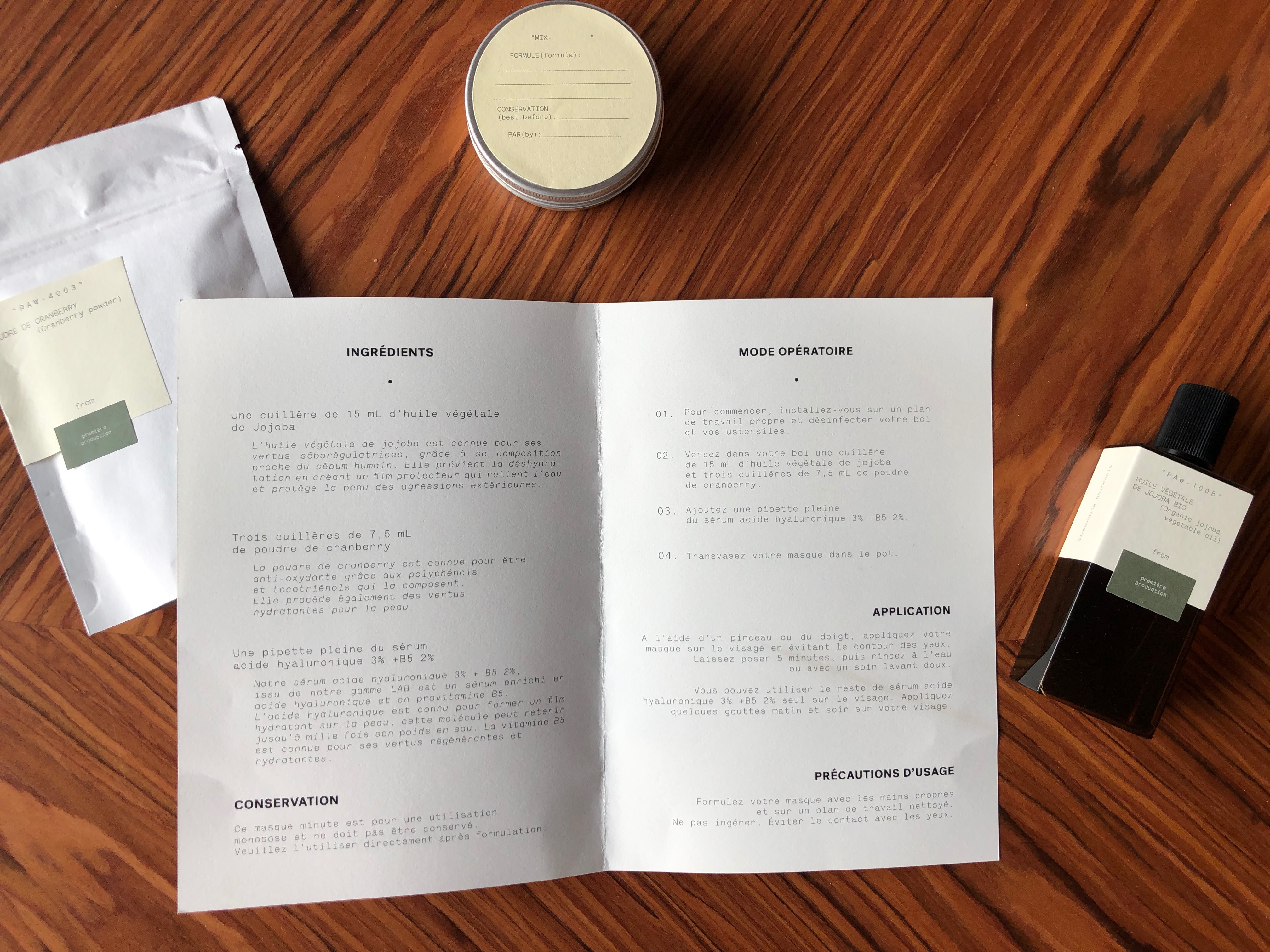
Powered by WPeMatico
Mixmax brings LinkedIn integration and better task automation to its Gmail tool
Mixmax today introduced version 2.0 of its Gmail-based tool and plugin for Chrome that promises to make your daily communications chores a bit easier to handle.
With version 2.0, Mixmax gets an updated editor that better integrates with the current Gmail interface and that gets out of the way of popular extensions like Grammarly. That’s table stakes, of course, but I’ve tested it for a bit and the new version does indeed do a better job of integrating itself into the current Gmail interface and feels a bit faster, too.
What’s more interesting is that the service now features a better integration with LinkedIn . There’s both an integration with the LinkedIn Sales Navigator, LinkedIn’s tool for generating sales leads and contacting them, and LinkedIn’s messaging tools for sending InMail and connection requests — and sees info about a recipient’s LinkedIn profile, including the LinkedIn Icebreakers section — right from the Mixmax interface.
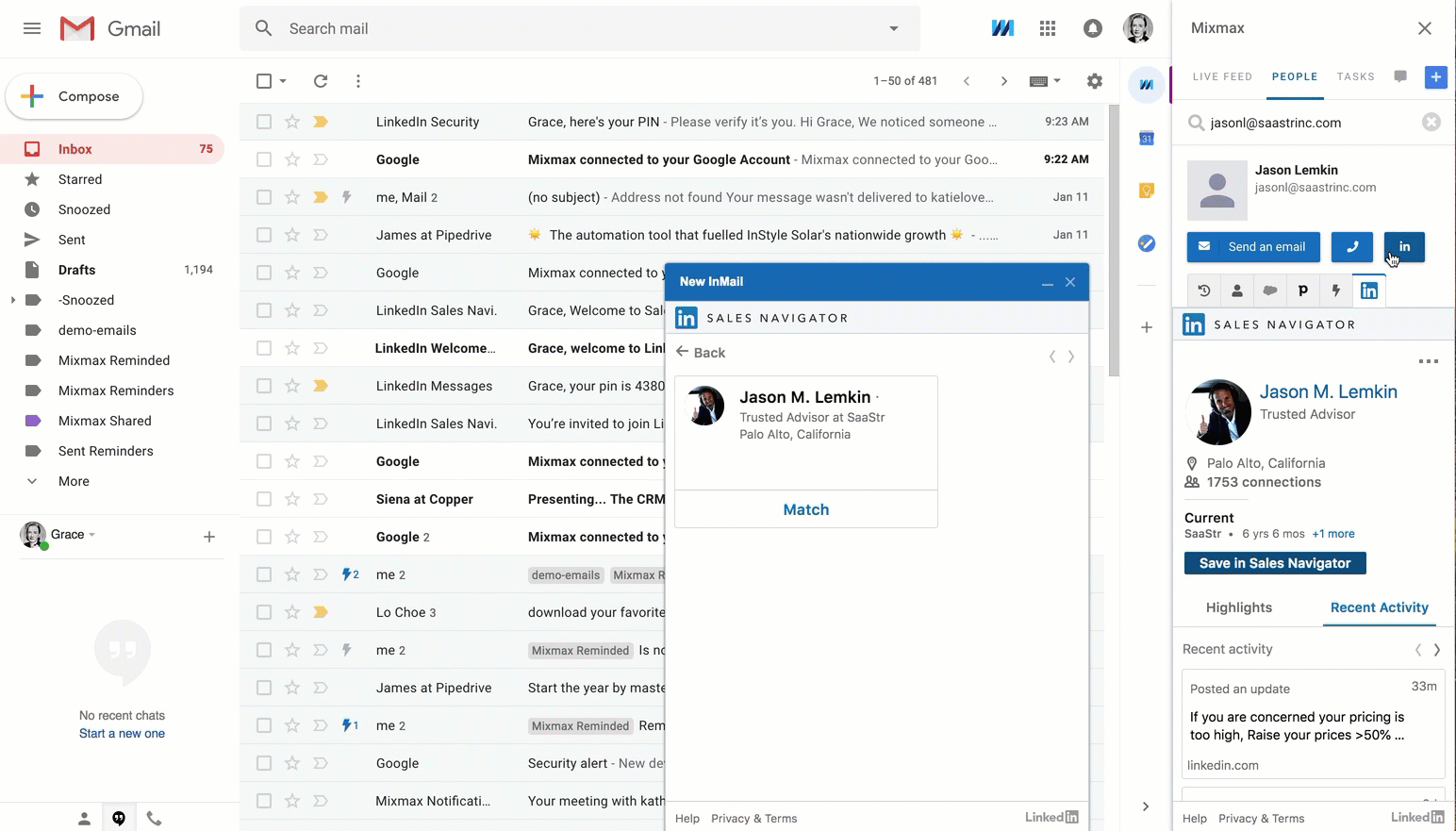
Together with its existing Salesforce integration, this should make the service even more interesting to sales people. And the Salesforce integration, too, is getting a bit of a new feature that can now automatically create a new contact in the CRM tool when a prospect’s email address — maybe from LinkedIn — isn’t in your database yet.
Also new in Mixmax 2.0 is something the company calls “Beast Mode.” Not my favorite name, I have to admit, but it’s an interesting task automation tool that focuses on helping customer-facing users prioritize and complete batches of tasks quickly and that extends the service’s current automation tools.
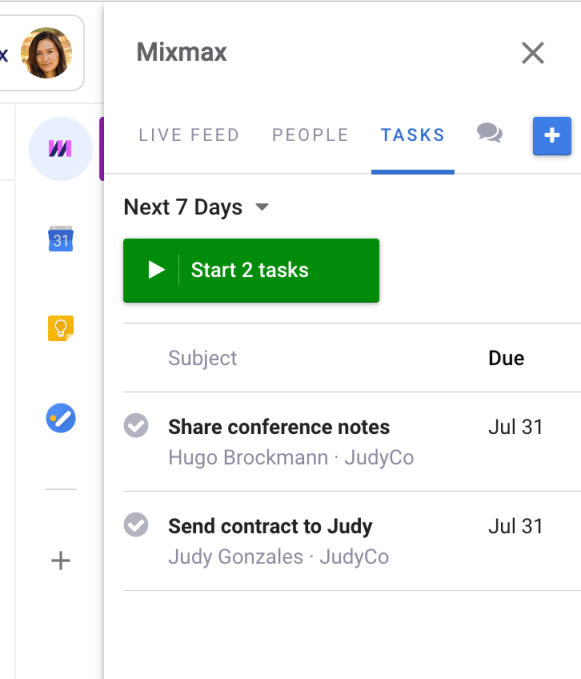 Finally, Mixmax now also features a Salesforce-linked dialer widget for making calls right from the Chrome extension.
Finally, Mixmax now also features a Salesforce-linked dialer widget for making calls right from the Chrome extension.
“We’ve always been focused on helping business people communicate better, and everything we’re rolling out for Mixmax 2.0 only underscores that focus,” said Mixmax CEO and co-founder Olof Mathé. “Many of our users live in Gmail and our integration with LinkedIn’s Sales Navigator ensures users can conveniently make richer connections and seamlessly expand their networks as part of their email workflow.”
Whether you get these new features depends on how much you pay, though. Everybody, including free users, gets access to the refreshed interface. Beast Mode and the dialer are available with the enterprise plan, the company’s highest-level plan which doesn’t have a published price. The dialer is also available for an extra $20/user/month on the $49/month/user Growth plan. LinkedIn Sales Navigator support is available with the growth and enterprise plans.
Sadly, that means that if you are on the cheaper Starter and Small Business plans ($9/user/month and $24/user/month respectively), you won’t see any of these new features anytime soon.
Powered by WPeMatico
Google’s hybrid cloud platform is now in beta
Last July, at its Cloud Next conference, Google announced the Cloud Services Platform, its first real foray into bringing its own cloud services into the enterprise data center as a managed service. Today, the Cloud Services Platform (CSP) is launching into beta.
It’s important to note that the CSP isn’t — at least for the time being — Google’s way of bringing all of its cloud-based developer services to the on-premises data center. In other words, this is a very different project from something like Microsoft’s Azure Stack. Instead, the focus is on the Google Kubernetes Engine, which allows enterprises to then run their applications in both their own data centers and on virtually any cloud platform that supports containers.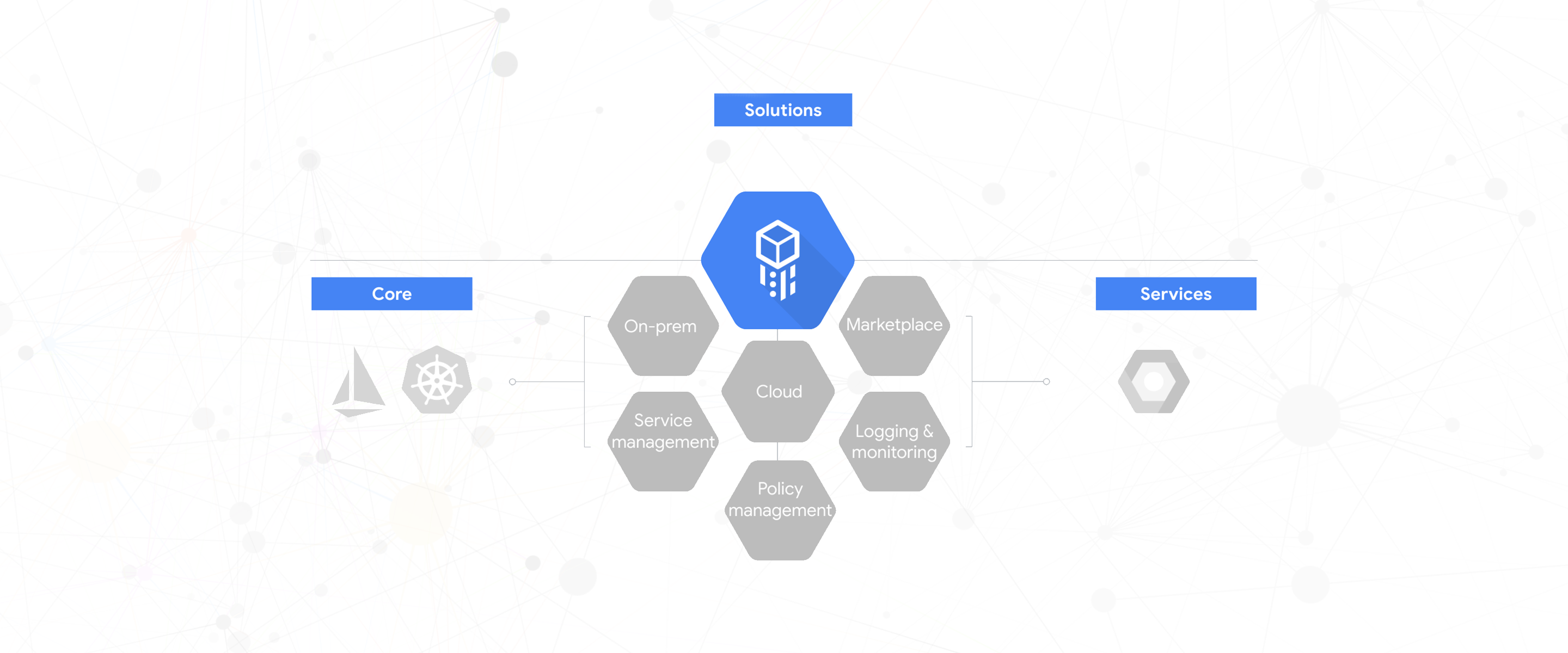 As Google Cloud engineering director Chen Goldberg told me, the idea here it to help enterprises innovate and modernize. “Clearly, everybody is very excited about cloud computing, on-demand compute and managed services, but customers have recognized that the move is not that easy,” she said and noted that the vast majority of enterprises are adopting a hybrid approach. And while containers are obviously still a very new technology, she feels good about this bet on the technology because most enterprises are already adopting containers and Kubernetes — and they are doing so at exactly the same time as they are adopting cloud and especially hybrid clouds.
As Google Cloud engineering director Chen Goldberg told me, the idea here it to help enterprises innovate and modernize. “Clearly, everybody is very excited about cloud computing, on-demand compute and managed services, but customers have recognized that the move is not that easy,” she said and noted that the vast majority of enterprises are adopting a hybrid approach. And while containers are obviously still a very new technology, she feels good about this bet on the technology because most enterprises are already adopting containers and Kubernetes — and they are doing so at exactly the same time as they are adopting cloud and especially hybrid clouds.
It’s important to note that CSP is a managed platform. Google handles all of the heavy lifting like upgrades and security patches. And for enterprises that need an easy way to install some of the most popular applications, the platform also supports Kubernetes applications from the GCP Marketplace.
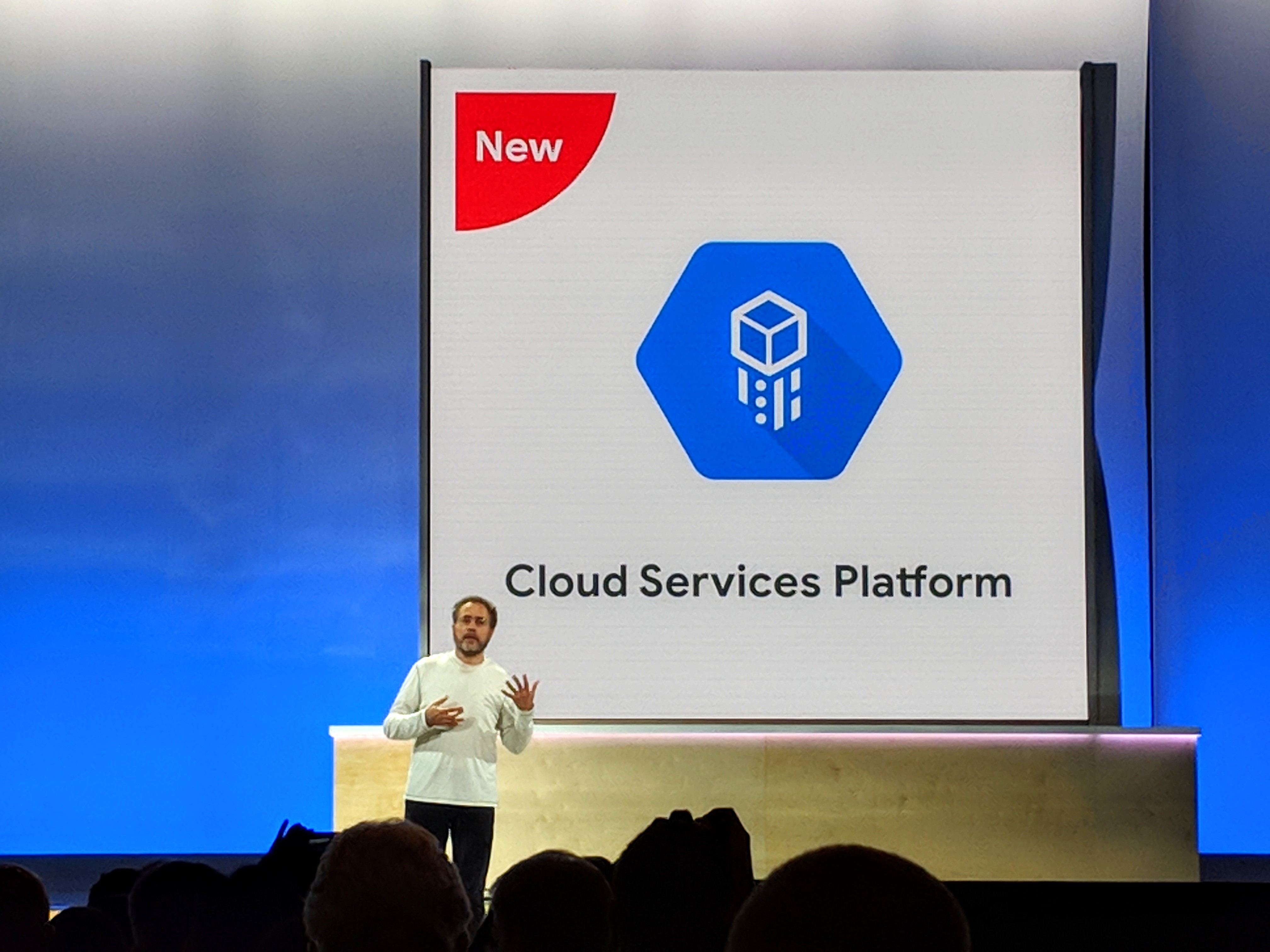
As for the tech itself, Goldberg stressed that this isn’t just about Kubernetes. The service also uses Istio, for example, the increasingly popular service mesh that makes it easier for enterprises to secure and control the flow of traffic and API calls between its applications.
With today’s release, Google is also launching its new CSP Config Management tool to help users create multi-cluster policies and set up and enforce access controls, resource quotas and more. CSP also integrates with Google’s Stackdriver Monitoring service and continuous delivery platforms.
“On-prem is not easy,” Goldberg said, and given that this is the first time the company is really supporting software in a data center that is not its own, that’s probably an understatement. But Google also decided that it didn’t want to force users into a specific set of hardware specifications like Azure Stack does, for example. Instead, CSP sits on top of VMware’s vSphere server virtualization platform, which most enterprises already use in their data centers anyway. That surely simplifies things, given that this is a very well-understood platform.
Powered by WPeMatico
How to watch Samsung unveil the Galaxy S10
Today’s the day we finally see the Galaxy S10 — well, officially, at least. As is the tradition with Samsung product launches, the news has already been leaking out at a furious pace. Here’s a decent breakdown of what we expect from the new flagship — though to be fair, plenty more leaks have surfaced since then, including an ad for the S10 and Galaxy Buds.
We also just got a name for the foldable phone we expect to debut alongside numerous new S10 models. That’s the Galaxy Fold, to you.
Of course, Samsung always announces a lot — so there are bound to be some surprises. Heck, the company didn’t splinter off from Mobile World Congress this year for nothing.
All will be revealed at this link or below, today, starting at 11AM PT (2PM ET).
Powered by WPeMatico
New conflict evidence surfaces in JEDI cloud contract procurement process
For months, the drama has been steady in the Pentagon’s decade-long, $10 billion JEDI cloud contract procurement process. This week the plot thickened when the DOD reported that it has found new evidence of a possible conflict of interest, and has reopened its internal investigation into the matter.
“DOD can confirm that new information not previously provided to DOD has emerged related to potential conflicts of interest. As a result of this new information, DOD is continuing to investigate these potential conflicts,” Elissa Smith, Department of Defense spokesperson told TechCrunch.
It’s not clear what this new information is about, but The Wall Street Journal reported this week that senior federal judge Eric Bruggink of the U.S. Court of Federal Claims ordered that the lawsuit filed by Oracle in December would be put on hold to allow the DOD to investigate further.
From the start of the DOD RFP process, there have been complaints that the process itself was designed to favor Amazon, and that were possible conflicts of interest on the part of DOD personnel. The DOD’s position throughout has been that it is an open process and that an investigation found no bearing for the conflict charges. Something forced the department to rethink that position this week.
Oracle in particular has been a vocal critic of the process. Even before the RFP was officially opened, it was claiming that the process unfairly favored Amazon. In the court case, it made the conflict part clearer, claiming that an ex-Amazon employee named Deap Ubhi had influence over the process, a charge that Amazon denied when it joined the case to defend itself. Four weeks ago something changed when a single line in a court filing suggested that Ubhi’s involvement may have been more problematic than the DOD previously believed.
At the time, I wrote:
In the document, filed with the court on Wednesday, the government’s legal representatives sought to outline its legal arguments in the case. The line that attracted so much attention stated, “Now that Amazon has submitted a proposal, the contracting officer is considering whether Amazon’s re-hiring Mr. Ubhi creates an OCI that cannot be avoided, mitigated, or neutralized.” OCI stands for Organizational Conflict of Interest in DoD lingo.
And Pentagon spokesperson Heather Babb told TechCrunch:
During his employment with DDS, Mr. Deap Ubhi recused himself from work related to the JEDI contract. DOD has investigated this issue, and we have determined that Mr. Ubhi complied with all necessary laws and regulations.
Whether the new evidence that DOD has found is referring to Ubhi’s rehiring by Amazon or not is not clear at the moment, but it has clearly found new evidence it wants to explore in this case, and that has been enough to put the Oracle lawsuit on hold.
Oracle’s court case is the latest in a series of actions designed to protest the entire JEDI procurement process. The Washington Post reported last spring that co-CEO Safra Catz complained directly to the president. The company later filed a formal complaint with the Government Accountability Office (GAO), which it lost in November when the department’s investigation found no evidence of conflict. It finally made a federal case out of it when it filed suit in federal court in December, accusing the government of an unfair procurement process and a conflict on the part of Ubhi.
The cloud deal itself is what is at the root of this spectacle. It’s a 10-year contract worth up to $10 billion to handle the DOD’s cloud business — and it’s a winner-take-all proposition. There are three out clauses, which means it might never reach that number of years or dollars, but it is lucrative enough, and could possibly provide inroads for other government contracts, that every cloud company wants to win this.
The RFP process closed in October and the final decision on vendor selection is supposed to happen in April. It is unclear whether this latest development will delay that decision.
Powered by WPeMatico
QuizUp founder launches Teatime, a mobile gaming platform with built-in video chat
At the end of 2016, Plain Vanilla founder Thor Fridriksson left the company he founded with the intent to take at least a year off of work.
His product QuizUp, a social trivia game that raised more than $40 million and said it had more than 100 million users, never truly found a way to monetize. After a few missteps, including a proposed TV deal that eventually got cancelled, Plain Vanilla was acquired by Glu Mobile for a deal reportedly valued at $7.5 million.
Fridriksson was only a few weeks into his planned yearlong vacation when he became restless and asked a few members of his core team at QuizUp — Gunnar Holmsteinn, Johann Thorvaldur Bergthorsson and Ymir Finnbogason — to start brainstorming with him about the future of mobile gaming.
That’s where the seed was planted for what would eventually become Teatime.
“The main thing we kept focusing on, and it seems straightforward and common sense but these things often do in retrospect, is why people play games,” said Fridriksson. “One of the main value propositions of playing a game is not about the game itself but about the human interaction you have while playing with someone — talking to the people you’re playing with and seeing their reactions.”
Teatime Live is a mobile gaming platform that allows users to interact with one another, face to face, while playing games on their phone through a built-in video chat. On top of the video chat, Teatime Live offers users Snapchat-style face filters called Game Faces, that are unique to each individual game on the platform. Players can take their earned game faces from one game to other games, and eventually, Fridriksson sees the opportunity for these items to be collectibles.
Most forms of games or sports have a social element built in. Whether it’s board games or physical sports or even video games, players have been able to communicate with one another in some way shape or form. That simply hasn’t been the case on mobile, which means that it’s still unclear what the best possible game for this platform looks like.
Teatime is debuting the platform with Hyperspeed, a simple racer game that the company developed in house. Teatime will continue to operate as a studio and build out other titles on top of the Teatime Live platform, but it also plans to work alongside other game developers as a publishing partner.
There are obvious concerns around enabling live video chat among strangers across the internet, and Teatime has tried to take steps toward preventing abuse.
To start, users are not allowed to play Teatime games as a guest. All players must sign up with Facebook, Gmail or a phone number, which means bad actors will have a more taxing time getting back on the platform with a new username.
More importantly, Teatime’s game-face filters require facial recognition technology, which means that the system knows when there is no face visible in the camera. Unless a user is playing with someone that they’ve friended, Teatime will blur the picture whenever a face isn’t visible in the camera.
As per usual, Teatime also has a team of moderators going through profile pictures, etc. and a user reporting system.
Teatime hopes to build games around relatively proven models in mobile gaming to earn revenue on its own games, while sharing revenue with other game developers who build on the platform.
Teatime has raised $9 million in Series A funding from Atomico and Index Ventures.
Powered by WPeMatico

